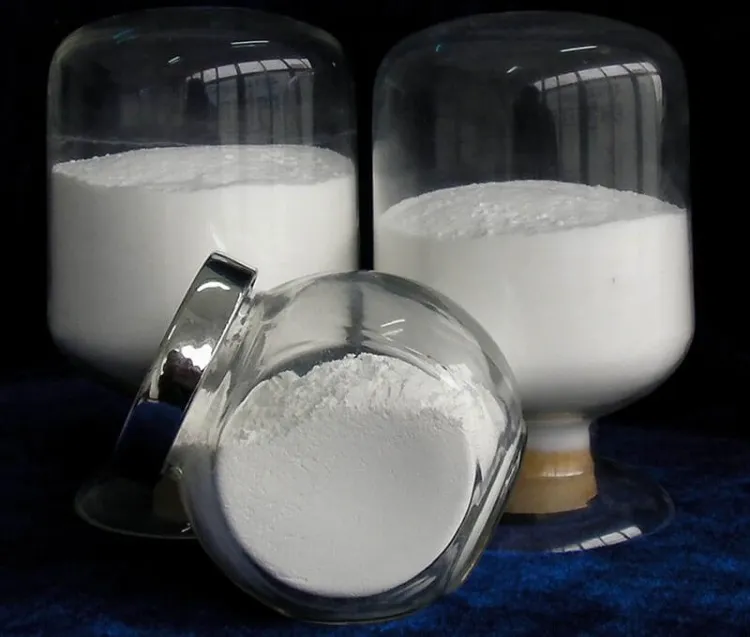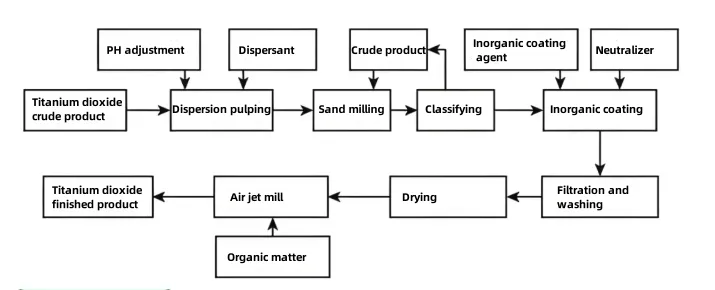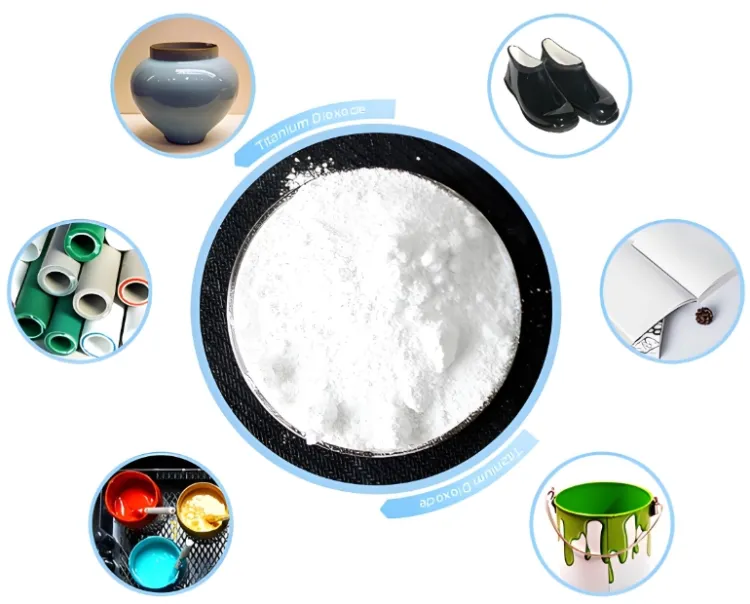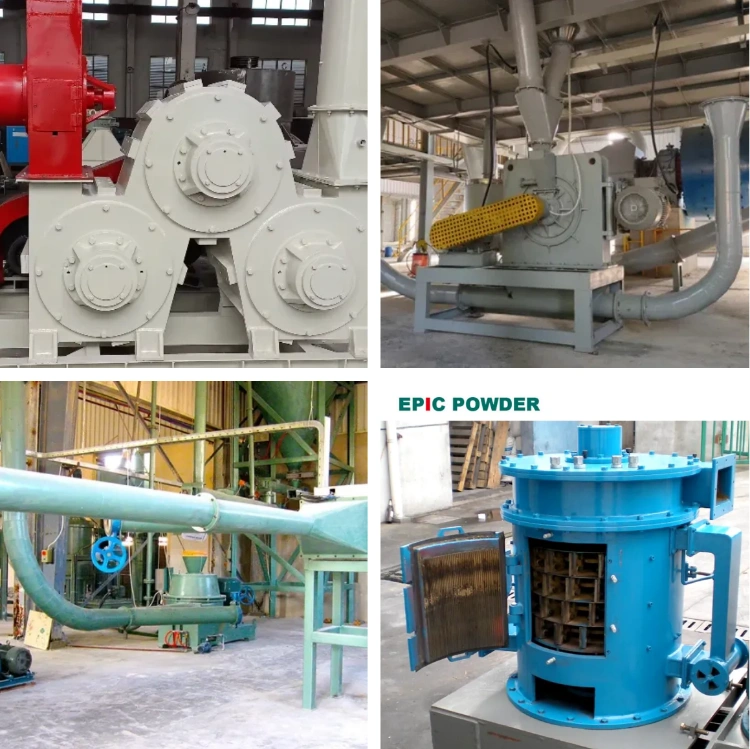The pengubahsuaian salutan daripada titanium dioksida (TiO₂) ialah kaedah penting untuk memperbaiki sifatnya, seperti serakan, rintangan cuaca, kilauan, dan kimia kestabilan. Melalui titanium dioksida salutan pengubahsuaian, prestasi TiO₂ boleh dipertingkatkan dengan ketara untuk pelbagai aplikasi perindustrian. Kaedah salutan biasa dibahagikan kepada tiga kategori: salutan bukan organik, salutan organik, dan salutan komposit. Di bawah ialah klasifikasi khusus dan pengenalan ringkas kaedah pengubahsuaian salutan titanium dioksida ini, menonjolkan faedah uniknya untuk pelbagai aplikasi.

Pengubahsuaian salutan bukan organik
Oleh salutan lapisan oksida bukan organik atau garam pada permukaan zarah titanium dioksida, halangan fizikal dibentuk untuk meningkatkan kestabilan kimia dan sifat optiknya.

Salutan oksida
Prinsip: Oksida logam terhidrat (cth, SiO₂, Al₂O₃, ZrO₂) memendakan pada permukaan TiO₂ untuk membentuk lapisan salutan yang seragam.
Jenis Biasa:
- Salutan silika (SiO₂): Meningkatkan penyebaran dan rintangan cuaca, mengurangkan penggumpalan, digunakan dalam salutan dan plastik.
- Salutan alumina (Al₂O₃): Meningkatkan kekutuban permukaan, meningkatkan keserasian dengan matriks organik, meningkatkan kilauan dan rintangan kimia.
- Salutan zirkonia (ZrO₂): Meningkatkan suhu tinggi dan rintangan haus, sesuai untuk salutan dan seramik berprestasi tinggi.
Proses: Garam logam (cth, natrium silikat, aluminium sulfat) ditambah ke dalam buburan TiO₂, melaraskan pH untuk memendakan hidrat logam oksida.
Salutan oksida komposit
Prinsip: Salutan dengan dua atau lebih oksida logam (cth, Al₂O₃-SiO₂, ZrO₂-SiO₂) menggabungkan kelebihan setiap komponen.
Ciri-ciri: Menawarkan prestasi keseluruhan yang unggul. Sebagai contoh, salutan Al₂O₃-SiO₂ meningkatkan kedua-dua serakan dan rintangan cuaca, sesuai untuk cat automotif berprestasi tinggi dan salutan gegelung.
Salutan garam
Prinsip: Garam logam (cth, fosfat, silikat, sulfat) membentuk lapisan garam tidak larut pada permukaan TiO₂.
Jenis Biasa:
- Salutan aluminium fosfat: Meningkatkan rintangan cuaca dan keupayaan anti-serbuk, yang biasa digunakan dalam salutan luar.
- Salutan zink sulfat: Memperbaiki sifat cas permukaan, mengurangkan penggumpalan, dan meningkatkan penyebaran.
Pengubahsuaian salutan organik
Melalui tindak balas sebatian organik dengan kumpulan hidroksil pada permukaan titanium dioksida, lapisan molekul organik terbentuk untuk meningkatkan keserasiannya dengan media organik.
Salutan ejen gandingan
Prinsip: Molekul agen pengganding (cth, silanes, titanat, aluminat) mempunyai struktur amphiphilic, dengan satu hujung terikat kepada kumpulan hidroksil TiO₂ dan satu lagi bertindak balas dengan matriks organik (cth, resin, polimer).
Fungsi:
- Ejen gandingan silane: Meningkatkan penyebaran TiO₂ dalam sistem akueus, biasanya digunakan dalam salutan dan dakwat berasaskan air.
- Ejen gandingan Titanate / Aluminat: Tingkatkan keserasian dalam sistem berminyak seperti plastik dan getah, mengurangkan penggumpalan semasa pemprosesan.
Salutan surfaktan
Prinsip: Surfaktan (cth, asid lemak, sulfonat, garam ammonium kuaterner) melekat pada permukaan TiO₂ melalui penjerapan fizikal atau tindak balas kimia, membentuk cas atau lapisan hidrofobik.
Fungsi:
- Surfaktan anionik (cth, asid stearik): Memperbaiki penyebaran dalam media berminyak, biasanya digunakan dalam plastik dan getah.
- Surfaktan kationik (cth, dodesiltrimetilammonium klorida): Sesuai untuk sistem kutub, meningkatkan kestabilan.
Salutan polimer
Prinsip: Cantuman polimer (cth, akrilat, resin epoksi, siloksan) dicapai melalui tindak balas pempolimeran pada permukaan TiO₂.
Fungsi: Membentuk lapisan salutan tebal, mengasingkan lagi kakisan kimia, meningkatkan rintangan cuaca dan sifat mekanikal. Meningkatkan keserasian dengan resin tertentu, sesuai untuk komposit dan salutan berprestasi tinggi.
Salutan silikon
Prinsip: Poliorganosiloksana (cth, silikon, resin silikon) menyaluti zarah TiO₂ kerana sifat tenaga permukaannya yang rendah.
Fungsi: Mengurangkan ketegangan permukaan, meningkatkan penyebaran dan kelancaran, yang biasa digunakan dalam dakwat dan kosmetik.
Pengubahsuaian salutan komposit
Menggabungkan kelebihan salutan bukan organik dan organik, salutan berganda dijalankan secara berperingkat atau serentak untuk mencapai prestasi pelengkap.
Bukan organik dahulu kemudian salutan organik
Proses: Mula-mula, bentuk penghalang fizikal dengan oksida tak organik (cth, SiO₂), kemudian ubah suai dengan agen gandingan atau polimer untuk peningkatan organik.
Ciri-ciri: Mengimbangi rintangan cuaca dan keserasian, seperti dalam salutan seni bina tahan cuaca tinggi atau cat automotif OEM.
Salutan segerak bukan organik-organik
Proses: Pada masa yang sama memperkenalkan salutan bukan organik dan organik dalam sistem tindak balas yang sama untuk membentuk struktur kulit teras.
Ciri-ciri: Lapisan salutan mengikat lebih erat, membawa kepada peningkatan prestasi yang ketara. Sesuai untuk aplikasi mewah, seperti salutan aeroangkasa dan nanokomposit.
Teknologi salutan khas lain
Salutan nano
Prinsip: Gunakan bahan nano (cth, nano SiO₂, nano ZnO) untuk salutan bagi meningkatkan keupayaan dan ketelusan pelindung UV, yang biasa digunakan dalam kosmetik pelindung matahari dan salutan optik.
Salutan mikrokapsul
Prinsip: Bungkus zarah TiO₂ dalam mikrokapsul polimer, melepaskan TiO₂ dengan mengawal keadaan pecah kapsul (cth, suhu, pH). Sesuai untuk salutan pintar dan sistem pelepasan terkawal.
Kesimpulan
Pilihan daripada pengubahsuaian salutan titanium dioksida hendaklah berdasarkan senario aplikasi (cth, salutan, plastik, dakwat, kosmetik) dan keperluan prestasi (cth, rintangan cuaca, serakan, keserasian).

Contohnya:
- Salutan luar: Oksida bukan organik (cth, Al₂O₃-SiO₂) atau salutan komposit lebih disukai untuk meningkatkan rintangan cuaca.
- Pemprosesan plastik: Ejen gandingan atau surfaktan digunakan untuk meningkatkan prestasi penyebaran dan pemprosesan.
- Aplikasi mewah: Salutan komposit atau nano membolehkan pengoptimuman sinergi pelbagai fungsi.

serbuk epik
Serbuk Epik, 20+ tahun pengalaman kerja dalam industri serbuk ultrahalus. Secara aktif menggalakkan pembangunan serbuk ultra-halus masa hadapan, memfokuskan pada proses penghancuran, pengisaran, pengelasan dan pengubahsuaian serbuk ultra-halus. Hubungi kami untuk perundingan percuma dan penyelesaian tersuai! Pasukan pakar kami berdedikasi untuk menyediakan produk dan perkhidmatan berkualiti tinggi untuk memaksimumkan nilai pemprosesan serbuk anda. Serbuk Epik—Pakar Pemprosesan Serbuk Dipercayai Anda!
